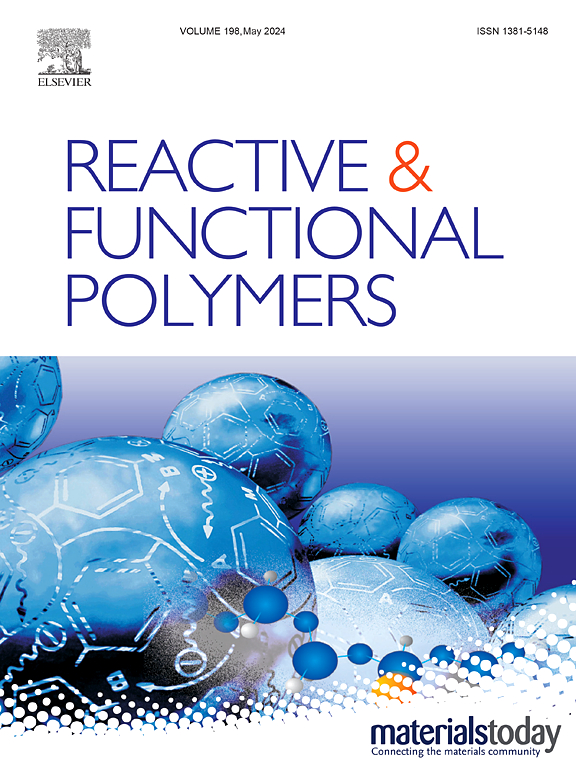Schiff bases and oligomers derived from trifluoromethylaniline-based monomers: Thermal, optical, electrochemical properties and applications as fluorescent probes for Sn2+
IF 4.5
3区 工程技术
Q1 CHEMISTRY, APPLIED
引用次数: 0
Abstract
Within the scope of the study, three different Schiff bases were synthesized from 3,5-bis(trifluoromethyl)aniline, a halogen-containing aniline derivative, with three different aldehydes, 3-hydroxy-4-methoxy-benzaldehyde, salicylaldehyde and 2-hydroxy-1-naphthaldehyde. These three synthesized Schiff bases were evaluated as monomers and oxidatively polymerized in the presence of sodium hypochlorite, a strong oxidant. The structural properties of these three monomers and three polymers were elucidated with the help of UV–Vis, FT-IR, 1H NMR, 13C NMR spectra. Their molecular weights were determined by gel permeation chromatography (GPC) and it was determined that the macromolecules obtained as a result of the oxidation reaction were in the oligomer order. In order to investigate their electrochemical properties, cyclic voltammetry (CV) was used to find their oxidation-reduction potentials. The HOMO-LUMO potentials and electrochemical band gap values of the synthesized Schiff bases and oligomers were calculated. Thermal stabilities of the monomers and oligomers were determined by thermogravimetric-differantial thermal analysis (TG-DTA). It was determined that the thermal stabilities of the obtained oligomers were higher than those of the Schiff bases. The glass transition temperature (Tg) and surface morphologies of oligomers were determined from DSC and SEM measurements, respectively. Their optical properties were examined by UV–Vis and fluorescence spectra. It was found that 1-(((3,5-bis(trifluoromethyl)phenyl)imino)methyl) naphthalene-2-ol (TFMHN), one of the Schiff bases, has a turn-on fluorescence sensor property with increasing fluorescence emission intensity in the presence of Sn2+ among a series of metal ions and can be used as a selective and sensitive fluorescence probe for Sn2+ with a limit of dedection (LOD) value of 7.14 × 10−8 M.

希夫碱和从三氟甲基苯胺基单体衍生的低聚物:热、光学、电化学性质及其作为Sn2+荧光探针的应用
在本研究范围内,由含卤素苯胺衍生物3,5-二(三氟甲基)苯胺与3-羟基-4-甲氧基-苯甲醛、水杨醛和2-羟基-1-萘醛三种不同的醛合成了三种不同的希夫碱。这三种合成的希夫碱作为单体进行了评价,并在次氯酸钠(一种强氧化剂)存在下进行了氧化聚合。通过UV-Vis、FT-IR、1H NMR、13C NMR对这3种单体和3种聚合物的结构性质进行了表征。用凝胶渗透色谱法(GPC)测定了它们的分子量,并确定氧化反应得到的大分子为低聚物。为了研究它们的电化学性质,用循环伏安法(CV)测定了它们的氧化还原电位。计算了合成的希夫碱和低聚物的HOMO-LUMO电位和电化学带隙值。用热重差热分析(TG-DTA)测定了单体和低聚物的热稳定性。结果表明,所得低聚物的热稳定性高于希夫碱的热稳定性。玻璃化转变温度(Tg)和低聚物的表面形貌分别通过DSC和SEM测量确定。用紫外可见光谱和荧光光谱检测了它们的光学性质。结果表明,席夫碱之一的1-(((3,5-二(三氟甲基)苯基)亚氨基)甲基)萘-2-醇(TFMHN)在一系列金属离子中Sn2+存在时具有开启荧光传感器特性,荧光发射强度增加,可作为Sn2+的选择性灵敏荧光探针,检出限(LOD)值为7.14 × 10−8 M。
本文章由计算机程序翻译,如有差异,请以英文原文为准。
求助全文
约1分钟内获得全文
求助全文
来源期刊

Reactive & Functional Polymers
工程技术-高分子科学
CiteScore
8.90
自引率
5.90%
发文量
259
审稿时长
27 days
期刊介绍:
Reactive & Functional Polymers provides a forum to disseminate original ideas, concepts and developments in the science and technology of polymers with functional groups, which impart specific chemical reactivity or physical, chemical, structural, biological, and pharmacological functionality. The scope covers organic polymers, acting for instance as reagents, catalysts, templates, ion-exchangers, selective sorbents, chelating or antimicrobial agents, drug carriers, sensors, membranes, and hydrogels. This also includes reactive cross-linkable prepolymers and high-performance thermosetting polymers, natural or degradable polymers, conducting polymers, and porous polymers.
Original research articles must contain thorough molecular and material characterization data on synthesis of the above polymers in combination with their applications. Applications include but are not limited to catalysis, water or effluent treatment, separations and recovery, electronics and information storage, energy conversion, encapsulation, or adhesion.
 求助内容:
求助内容: 应助结果提醒方式:
应助结果提醒方式:


